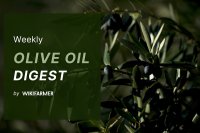Wheat is considered to be the most important staple food globally. Up to 55% of the population of the world depends on this crop for 20% of calory intake (1). The crop prevails in temperate zones and is an important source of income for millions of small and medium holder farmers.
Wheat plant information
Wheat belongs to the grass family (Poaceae), and it is a C3, annual (or biennial) plant. The crop is mostly cultivated to produce grains, but it can also be used as an annual forage crop (hay and silage) or as pasture. In this case, the harvest takes place a bit earlier in the soft dough stage or at the boot stage. Wheat plants grow as a bunch grass with the production of a central erect stem, 1.2 m (4 ft) high, and numerous tillers (up to 35). Some of the tillers will enter the reproduction stage and contribute to the final yield, while others will not.
To identify wheat species from other grain crops (especially in the early stages), many people check if the short auricles and the leaf sheath are hairy or not. In the wheat species, auricles are hairy while leaf-sheath is not (2). Winter wheat plants tend to produce more leaves than spring wheat, but in both cases, the last leaf produced, called the “flag leaf,” is the most important, due to its higher photosynthetic rate. Farmers should take all necessary measures to protect the health of the flag leaf since it contributes significantly to the development of the ear.
Wheat can be cultivated as a winter or spring crop. The cultivation period lasts up to 6-8 months for winter types while it can be a bit shorter for spring types. However, wheat can also be cultivated as an intermediate crop for 3-4 months. In all cases, from the sowing moment until harvest, wheat plants develop through certain stages (3):
- Sprouting-Emergence-Establishment
- Tillering-Stem Extention
- Booting
- Head development
- Flowering/Anthesis
- Grain filling (Milk development and Dough development)
- Ripening-Maturation
The time duration of each growth stage depends on the variety/cultivar, the temperature, day length, and sowing date of the crop. In general, when wheat is cultivated as a winter crop, tillering and head development stages last longer than the corresponding stages in spring-type wheat. For recognizing the different developmental stages of spring wheat, you can refer to the detailed guide of the University of Minnesota Extension (9).
The history of wheat cultivation and its importance to the Global Food System
Wheat numbers many species that belong in the Triticum genus, but the most important and widely cultivated is the Triticum aestivum (common or bread wheat) that together with T. turgidum was domesticated approximately around 7500 BC at the 'Fertile Crescent' area in Near and the Middle East (Bell, 1987, 4). The first initially cultivated species were the diploid Einkorn (Triticum monococcum) and the tetraploid Emmer wheat (Triticum dicoccum). The natural hybridization and the selection from the farmers "gave birth" to Durum, Spelt, and Common bread wheat (hexaploidy, six copies of the chromosomes). Wheat cultivation gradually expanded to the Balkans, central and western Europe. As the crop domesticated, farmers, breeders, and scientists selected and favored specific plant characteristics, thus they changed the physiology of wheat plants. As a result, the cultivars became shorter in height, while the number of tillers (per plant) generally reduced as well.
Today, the constantly increasing demand for the crop has expanded the cultivation range, from 67°N in Scandinavia and Russia to 45°S in Argentina (Feldman 1995). Of the total global production that is close to 761 million tonnes (FAOSTAT 5), 95% is bread wheat, while 4% is Durum (pasta wheat, Triticum turgidum) wheat and 1% Dicoccum (1). The latest data show that the countries with the highest wheat production are: China, India, Russia U.S, and France, while Ireland, the Netherlands, and New Zealand hold the records for yield production per hectare (6). Nowadays, scientists worldwide are "competing" to improve the yield and resistance of the crop to satisfy the global need of feeding 9.2 billion people by 2050, aiming at a 1.2% yield grain increase yearly (7).
Uses and Nutritional Value of wheat
The rich nutritional value of whole wheat, the amount and quality of the gluten that contains and offers energy and builds muscular tissue, as well as the long storage life, have made it the primary cereal for producing bread worldwide.
Roughly 1 bushel of wheat weighs 27,2 kg (60 lbs), contains around 1.000.000 kernels, and can produce 19,05 kg (42 lbs) of white flour and pasta.
The nutritional value of 100 g of raw whole-grain wheat (bran, endosperms, germ) (8):
- 340-360 kcal
- 10.3 g protein (gluten)
- 1 g total fat
- 73.6 g carbohydrates
- 2.7 g fiber
- 15 mg Calcium
- 1.2 mg Iron
- 22 mg Magnesium
- 108 mg Phosphorus
- 107 mg Potassium
- 2 mg Sodium
- 0.7 mg Zinc
- 0.1 mg Thiamin (B1), 0.04 mg Riboflavin (B2), 1.3 mg Niacin (B3), 0.04 mg Vit. B6
- 26 DFE Folate
To eliminate nutritional diseases like beriberi and pellagra, white flour has been enriched with B vitamins, thiamine, iron, riboflavin, niacin, and later folic acid. However, during the refining process of wheat, the germ is removed, leading to the loss of vitamins and minerals, aggravating digestive and nutritional disorders. Based on scientific evidence, it has been found that the baking process reduces the digestibility of wheat gluten proteins (Smith et al., 2015). The most common gluten digestibility intolerance is celiac disease, and people suffering from it should avoid consuming products containing high amounts of gluten.
Depending on the wheat species used, it can also be processed in different ways and used to produce numerous other food products like biscuits, pasta, noodles, chappatis, wheat beer, cosmetics, and meat substitute products (Kumar et al., 2011). While the kernels are the main plant part that is mostly used, straws of wheat plants can also be used as mulch, biomass for fuel production, part of compost, and for thatching, among others.
Finally, to successfully cultivate wheat and obtain high yield and good quality kernels, the farmer needs to invest some time in order to find the most suitable variety, prepare his/her soil in the best possible way before sowing and form an appropriate schedule for irrigation, weed management, and fertilization. Furthermore, in all growth stages, the farmer needs to take proactive and control measures to ensure the health of the plants and store the harvested products with caution, following the guidelines that will be further analyzed in the following articles.
References
- https://iiwbr.icar.gov.in/wp-content/uploads/2018/02/EB-52-Wheat-Cultivation-in-India-Pocket-Guide.pdf
- http://www.uwyo.edu/plantsciences/uwplant/forages/small-grains/wheat.html
- https://mccracken.ca.uky.edu/files/identifying_wheat_growth_stages_agr224.pdf
- https://www.fao.org/land-water/databases-and-software/crop-information/wheat/en/
- https://web.archive.org/web/20150906230329/http:/faostat.fao.org/site/567/DesktopDefault.aspx?PageID=567#ancor
- https://ourworldindata.org/crop-yields
- https://www.cimmyt.org/news/new-publications-the-importance-of-wheat-in-the-global-food-supply-to-a-growing-population/
- https://knowledge4policy.ec.europa.eu/health-promotion-knowledge-gateway/whole-grain-nutritional-value-whole-2_en
- Spring wheat growth and development guide (umn.edu)
Bell, G. D. H. (1987). The history of wheat cultivation. In Wheat breeding (pp. 31-49). Springer, Dordrecht.
Kumar, P., Yadava, R. K., Gollen, B., Kumar, S., Verma, R. K., & Yadav, S. (2011). Nutritional contents and medicinal properties of wheat: a review. Life Sciences and Medicine Research, 22(1), 1-10.
Smith, F., Pan, X., Bellido, V., Toole, G. A., Gates, F. K., Wickham, M. S., ... & Mills, E. C. (2015). Digestibility of gluten proteins is reduced by baking and enhanced by starch digestion. Molecular nutrition & food research, 59(10), 2034-2043.
Wheat Plant Information, History and Nutritional Value
Principles for selecting the best Wheat Variety
Wheat Soil preparation, Soil requirements, and Seeding requirements
Wheat Irrigation Requirements and Methods







